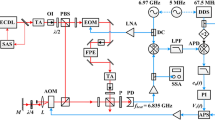The paper examines a key part of the laser system used in cold atomic gravimeters. The optical system of an atomic gravimeter requires the stabilization of laser frequency offset from the atomic transition. In this connection, the authors propose an offset frequency stabilization method for a frequency-doubled fiber laser. The developed method is based on modulation transfer spectroscopy and the use of a broadband electro-optic modulator. An experimental setup for implementing the proposed method is described. In the study, error signals were obtained, enabling the offset frequency stabilization of a frequency-doubled fiber laser. In order to achieve the maximum amplitude of the error signal, the following parameters of the experimental setup were optimized: cell temperature, the intensity of the probe and saturation beams, as well as the amplitudes of signals fed to the electro-optic modulators. In addition, the effect of radiation polarization on the signal amplitude was examined. Circular polarization is shown to produce an error signal having a higher amplitude. The obtained results can be used in the development of a quantum gravimeter, quantum frequency standards, as well as in experiments involving laser cooling of atoms.




Similar content being viewed by others
References
M. S. Aleynikov, V. N. Baryshev, I. Y. Blinov, D. S. Kupalov, and G. V. Osipenko, Prospects for the Development of a Sensitive Atomic Interferometer Based on Cold Rubidium Atoms, Izmer. Tekh., No. 7, 9–12 (2020), https://doi.org/10.32446/0368-1025it.2020-7-9-12.
M. Kasevich and S. Chu, Phys. Rev. Lett., 67, No. 2, 181–184 (1991), https://doi.org/10.1103/PhysRevLett.67.181.
C. So, N. L. Spong, C. Möhl, Y. Jiao, T. Ilieva, and C. S. Adams, Opt. Lett., 44, 5374–5377 (2019), https://doi.org/10.1364/OL.44.005374.
Q. Fu, X. Li, Z. Meng, and Y. Feng, Opt. Commun., 44, 132–137 (2018), https://doi.org/10.1016/j.optcom.2018.06.040.
W. Peng, L. Zhou, S. Long, J. Wang, and M. Zhan, Opt. Lett., 39, 2998–3001 (2014), https://doi.org/10.1364/OL.39.002998.
J. H. Shirley, Opt. Lett., 7, No. 11, 537–539 (1982), https://doi.org/10.1364/OL.7.000537.
D. J. McCarron, S. A. King, and S. L. Cornish, Meas. Sci. Technol., 19, No. 10, Article ID 105601 (2008), https://doi.org/10.1088/0957-0233/19/10/105601.
V. N. Baryshev, G. V. Osipenko, M. S. Aleinikov, and I. Y. Blinov, Raman–Ramsey Pulsed Excitation of Coherent Population Trapping Resonances in a 87Rb Cell with a Buffer Gas, Quantum Electron., 49, No. 3, pp. 283–287 (2019).
D. Sun, C. Zhou, L. Zhou, J. Wang, and M. Zhan, Opt. Express, 24, No. 10, 10649–10662 (2016), https://doi.org/10.1364/OE.24.010649.
L. Mudarikwa, K. Pahwa, and J. Goldwin, J. Phys. B: At. Mol. Opt., 45, No. 6, Article ID 065002 (2012), https://doi.org/10.1088/0953-4075/45/6/065002.
D. Steck, Rubidium 85 D Line Data (2019), available at: https://steck.us/alkalidata/rubidium85numbers.pdf (accessed: 12/23/2022).
D. A. Steck, Rubidium 87 D Line Data (2001), available at: https://steck.us/alkalidata/rubidium87numbers.pdf (accessed: 12/23/2022).
Author information
Authors and Affiliations
Corresponding author
Additional information
Translated from Izmeritel’naya Tekhnika, No. 1, pp. 4–7, January, 2023.
Rights and permissions
Springer Nature or its licensor (e.g. a society or other partner) holds exclusive rights to this article under a publishing agreement with the author(s) or other rightsholder(s); author self-archiving of the accepted manuscript version of this article is solely governed by the terms of such publishing agreement and applicable law.
About this article
Cite this article
Osipenko, G.V., Aleynikov, M.S. & Sukhoverskaya, A.G. Offset Laser Frequency Stabilization Using Modulation Transfer Spectroscopy. Meas Tech 66, 1–5 (2023). https://doi.org/10.1007/s11018-023-02182-0
Received:
Accepted:
Published:
Issue Date:
DOI: https://doi.org/10.1007/s11018-023-02182-0




